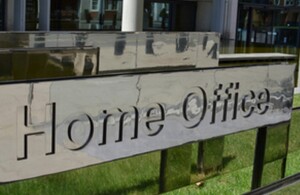Public to get a more detailed picture of crime outcomes
New categories in police recorded statistics will give the public a much clearer picture of how crime is being tackled in their communities.

Under the current system, 70 per cent of crimes are recorded as ‘undetected’, leaving victims and the public concerned that nothing has been done by police.
This will change with the introduction of a new recording framework. A new ‘community resolution’ category will recognise the community penalties that criminals receive.
Some forces already submit this data voluntarily, but from April 2013 all forces will be required to. This will increase transparency and improve accountability.
‘Undetected’ offences also include cases where ‘no further action’ was taken as the police were unable to mount a prosecution, either because there was insufficient evidence, the alleged victim did not want to proceed or because one party died after the offence was committed.
More details on why no further action was taken will start to be recorded from April 2014 after further consultation with police and other law enforcement agencies on sub-categories.
Policing and Criminal Justice Minister Damian Green said:
‘Recording offences as ‘undetected’ leaves victims feeling neglected and police investigations misunderstood - it does not properly reflect police work and that’s why we are scrapping it.
‘It is wholly inaccurate to suggest to the public that more than two thirds of all crimes are not investigated by the police, yet that is what these statistics currently show.
‘By introducing new categories, the police will be able to demonstrate the hard work they do and increase public transparency in policing.’
Including community penalties in the national statistics will build on the government’s new Community Remedy measure, which will give victims of low-level crime and anti-social behaviour a say in the out-of-court punishment of the offender. This will be introduced in new legislation later this year.
Notes to editors
-
For more information, contact the press office on 020 7035 3535.
-
The government’s consultation on the community remedy proposal closes on Thursday 7 March.
-
The 43 police forces in England and Wales and the British Transport Police provide the Home Office with aggregate returns on the number of notifiable crimes and detections they have recorded each year. Detected crimes are those crimes that have been ‘cleared up’ by the police.
-
The current ‘detection’ framework for recording crime outcomes is divided into two categories: sanction and non-sanction detections. The former occurs where the offender receives some formal sanction and the latter occurs in certain circumstances where the offence was ‘cleared up’ but no further action is taken against an offender, for example, where the alleged offender has died.
-
On 19 October 2012 the Government launched a targeted consultation seeking the views of directly affected parties to the revised framework, including the police, criminal justice practitioners, victims groups, the voluntary and community sector, other government departments, and organisations with a direct interest in crime data. Members of the public were also invited to comment. The consultation was published on the Home Office website.